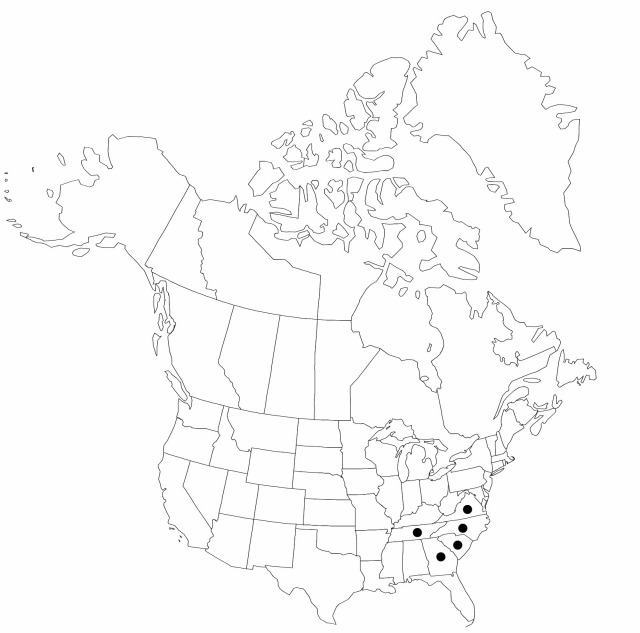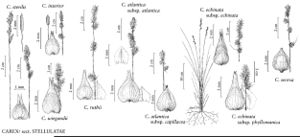Difference between revisions of "Carex ruthii"
in N. L. Britton et al., N. Amer. Fl. 18: 112. 1931.
FNA>Volume Importer |
imported>Volume Importer |
||
| (One intermediate revision by the same user not shown) | |||
| Line 1: | Line 1: | ||
{{Treatment/ID | {{Treatment/ID | ||
|accepted_name=Carex ruthii | |accepted_name=Carex ruthii | ||
| − | |accepted_authority=Mackenzie | + | |accepted_authority=Mackenzie |
|publications={{Treatment/Publication | |publications={{Treatment/Publication | ||
|title=in N. L. Britton et al., N. Amer. Fl. | |title=in N. L. Britton et al., N. Amer. Fl. | ||
|place=18: 112. 1931 | |place=18: 112. 1931 | ||
|year=1931 | |year=1931 | ||
| + | }} | ||
| + | |special_status={{Treatment/ID/Special_status | ||
| + | |code=F | ||
| + | |label=Illustrated | ||
| + | }}{{Treatment/ID/Special_status | ||
| + | |code=E | ||
| + | |label=Endemic | ||
}} | }} | ||
|basionyms= | |basionyms= | ||
| Line 35: | Line 42: | ||
-->{{#Taxon: | -->{{#Taxon: | ||
name=Carex ruthii | name=Carex ruthii | ||
| − | |authority=Mackenzie | + | |authority=Mackenzie |
|rank=species | |rank=species | ||
|parent rank=section | |parent rank=section | ||
| Line 48: | Line 55: | ||
|publication title=in N. L. Britton et al., N. Amer. Fl. | |publication title=in N. L. Britton et al., N. Amer. Fl. | ||
|publication year=1931 | |publication year=1931 | ||
| − | |special status= | + | |special status=Illustrated;Endemic |
| − | |source xml=https:// | + | |source xml=https://bitbucket.org/aafc-mbb/fna-data-curation/src/2e0870ddd59836b60bcf96646a41e87ea5a5943a/coarse_grained_fna_xml/V23/V23_584.xml |
|genus=Carex | |genus=Carex | ||
|section=Carex sect. Stellulatae | |section=Carex sect. Stellulatae | ||
Latest revision as of 20:41, 5 November 2020
Culms (23–)30–100 cm. Leaves 3–7 per culm; sheaths tight, inner band hyaline or straw colored, 6–18 cm, apex concave, glabrous; ligules rounded, 1–2.5 mm; blades plicate, 30–70 cm × 1.6–5 mm, widest leaf (2.6–)2.9–5 mm wide. Inflorescences (2.2–)3–8.5 cm; spikes 3–8; lateral spikes 3.6–11.2 mm, sessile, pistillate or gynecandrous, staminate portion 2-flowered, to 1 mm, pistillate portion 6–28-flowered, 3.6–11.2 mm; basal 2 spikes (5–)10–40 mm apart; terminal spike 7–15.5 mm, gynecandrous with staminate portion 3–14-flowered, 2–11(–14) × 0.8–1.6 mm and pistillate portion 10–25-flowered, 4.1–8 × 6.1–7.7 mm. Pistillate scales ovate, 1.4–2.2 × 1.1–2 mm, apex obtuse to acute. Staminate scales narrowly ovate, 1.6–2.4 × 1.1–1.9 mm, apex obtuse to acute. Anthers 0.8–1.45 mm. Perigynia spreading to reflexed, olive green, 6–14-veined abaxially, 0–5-veined adaxially, broadly to narrowly ovate, (2.8–)3–4.4 × 1.3–1.9(–2.1) mm, (1.6–)1.8–2.5 times as long as wide; beak 0.9–1.75 mm, 0.43–0.85 length of body, serrulate, teeth 0.15–0.35 mm. Achenes ovate, 1.1–1.8 × 0.9–1.4 mm.
Phenology: Fruiting late spring–early summer.
Habitat: Boggy meadows, open or wooded stream banks, springheads, seeps
Elevation: 700–1900 m
Distribution

Ga., N.C., S.C., Tenn., Va.
Discussion
Selected References
None.
